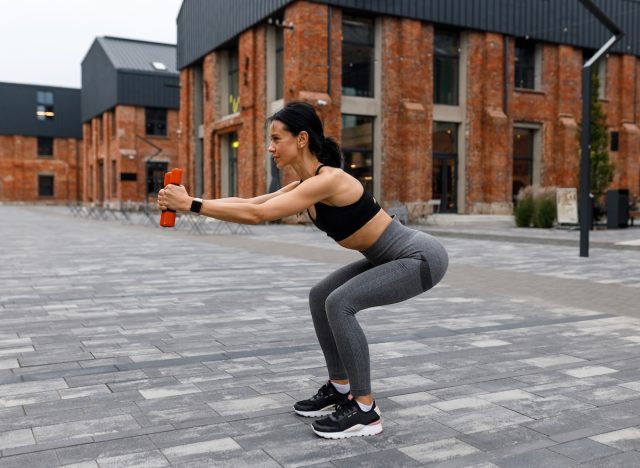6 Ways To Build Endurance For Longer, Faster Runs

Running is not only an invigorating sport, but it’s also chock-full of health benefits. Research shows that running can help prevent high blood pressure, stroke, heart disease, type 2 diabetes, obesity, some cancers, and more. If that’s not already enough goodness, more research proves that running can greatly impact your mental and emotional wellness. Heck, a 2021 study even revealed that long-distance runners can have better eyesight and memory. The list of benefits of putting on your sneakers and heading out for a run goes on.
If you’re a runner and you’re looking to step up your game to reap more of these incredible benefits, you may be wondering how to improve your endurance. Lucky for you, we spoke to Scott Brown, Orangetheory’s Vice President of Fitness, who shares with us some of the best ways to build endurance for longer, faster runs.
Brown tells us, “The frequency and combination of [the below] elements depend on the person’s current state of fitness, goals, available time, and preferences. As a general guideline, I recommend incorporating a mixture of these tips on a weekly basis, while prioritizing daily recovery strategies such as maintaining a healthy diet, staying hydrated, and establishing a consistent and adequate resting/sleeping schedule.”
Before you lace up and hit the pavement, check out some pro tips that will seriously improve your stride and take your running to the next level. So let’s get to it! Keep reading for the best ways to build endurance for longer, faster runs. And when you’re finished, check out these 5 Fitness Habits To Build Stamina & Endurance as You Age.
Go on long, slow runs.

You can definitely build up your endurance with long, slow runs. This method will get your metabolism ready for nonstop physical activity while sculpting muscle. “Do ‘Zone 2’ training,” Brown suggests. “Most people think you have to run hard and fast to improve—but running slow can lead to running faster, as this zone helps build your aerobic base.”
Do some sprints.

If you’re not a fan of sprints, you may want to reconsider your stance. Research shows that brief but vigorous sprinting can boost your VO2 max, which typically translates to better overall physical fitness. Brown stresses the importance of sprinting if you want to build endurance, explaining, “Incorporating high-intensity short duration intervals into your runs can help increase your capacity and power.”
Train on hills.

Training on hills can be quite the challenge, but once you master them, you’ll feel so accomplished. And the only way to get better at them is to train by running up them!
Hill training is actually something many athletes have in common, ScienceTraining explains. They run uphill at a moderate to quick level, whether it’s outdoors or getting in their strides on a treadmill. Plenty of endurance coaches favor uphill training when it comes to boosting an athlete’s speed. Doing hills can enhance the strength of your muscles, help you build up your speed, improve mental stamina, and get you going in a good rhythm.
“The SAID principle (Specific Adaptation to Imposed Demands) tells us that to get better at something, you must do that thing,” Brown says. He suggests alternating sprinting and doing hills every other week and going for a long run on a weekly basis.
Utilize capacity-building circuits.

“When heavy weights and absolute strength are not the primary objectives, consider creating or finding total-body circuits comprised of six to eight movements,” Brown suggests. “These movements should target all major muscle groups and elicit patterns across all planes of movement (front to back, side to side, rotational).”
When going through the circuit, incorporate light to moderate weights that challenge you but you’re able to successfully work with. The goal should be to complete the circuit continuously without much rest time for the entire time.
Establish a recovery plan.

Remember that recovery time is not only precious—it’s a must. Be sure to map out sufficient recovery time in between each running workout. Utilize as many recovery methods as you’re able to within that given time.
“These strategies can be as simple as eating clean, consuming the right number of calories, getting enough protein, staying hydrated, and getting plenty of sleep,” Brown says. “Play the long game here, as consistency in your training is the number one thing and if you are injured, you cannot be consistent.”
Strength train.

In addition to working on your cardio, strength training should absolutely be part of the equation. Brown recommends dedicating one to three days each week to strength exercises. You can do this via simple circuits or even heading to a workout class. “Participating in an Orangetheory session can provide additional running stimulus and help refine your heart rate response to various running protocols,” Brown adds.
- Source: https://pubmed.ncbi.nlm.nih.gov/31677122/
- Source: https://www.ncbi.nlm.nih.gov/pmc/articles/PMC2792566/
- Source: https://www.frontiersin.org/articles/10.3389/fnut.2022.944028/full
- Source: https://www.ncbi.nlm.nih.gov/pmc/articles/PMC7663387/
- Source: https://journals.lww.com/acsm-msse/Fulltext/2021/10000/Effects_of_Marathon_Running_on_Cognition_and.20.aspx
- Source: https://pubmed.ncbi.nlm.nih.gov/9609810/